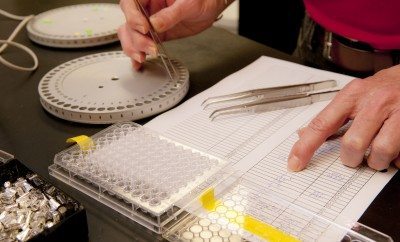 Image courtesy of [Ruhrfisch via Flickr]
Image courtesy of [Ruhrfisch via Flickr]
Health & Science
Infant Intersex Surgery: Genital Mutilation in the U.S.?
While many people from the United States often concern themselves with “female genital mutilation” in other countries, very few mainstream media sources focus on the nonconsensual surgeries on infants’ genitals that are frequently performed in hospitals in the United States. Approximately one out of every 1,200 births in the U.S. is an intersex child, and doctors generally treat these infants with genital surgeries.
What is the purpose of these genital surgeries, and why do intersex people and advocates often call these surgeries genital mutilation?
What Does it Mean to Have Intersex Traits?
Before discussing surgeries, it is first necessary to define what is meant by “intersex.” The Survivor Project defines intersex as:
The word that describes those of us who, without voluntary medical interventions, possess bodies that doctors can’t neatly classify as male or female. This includes people who have chromosomal sex other than XX (female) or XY (male), or primary or secondary sex characteristics that defy the medical definitions of male and female. Somehow, doctors [react negatively] when a newborn baby is found to be intersexed, and often mutilate her or his genitals to conform them to the doctors’ idea of what a normal baby should look like, even though intersex conditions usually do not threaten the health of the infant. Parents are often not given enough information or support to make an informed decision regarding their babies’ care.
Put another way, Inter/Act, a youth group for youth with intersex conditions, explains being intersex as:
An umbrella term describing people born with variations of internal and/or external sex anatomy resulting in bodies that can’t be classified as the typical male or female. We’re usually taught that sex is merely black and white, “male” or “female,” but that’s simply not true. There are a lot of awesome gray areas in the middle that could make someone intersex.
People with intersex traits are sometimes included in the LGBTQI acronym, but it is important to point out that being intersex does not necessarily mean that someone will not be straight. As a volunteer contributor to “Everyone is Gay!” and someone with intersex traits, Claudia of everyoneisgay.com writes of the debate regarding intersex inclusion and exclusion in queer circles:
People have questioned whether intersex issues really “fit” into the LGBT acronym or not. The LGBT acronym represents those with sexual orientations and gender identities outside the normative party line. And intersex isn’t a sexual orientation or a gender identity–it’s a bodily way of being. (Things can get a bit tricky here–some intersex people might identify their gender identity as “intersex,” and we need to allow intersex people–like all people–the room to identify however is authentic. Strictly speaking, however, intersex is about biology.)…Although intersex is about bodies, intersex people are fighting to be accepted, respected, and protected for being perceived as outside the norm. Since issues of bodily diversity are also often tied up in misunderstandings about how sex, gender, and sexual orientation fit together–hence, why so many people still advocate for “fixing” intersex people to make us “normal,”…including intersex people in LGBT issues makes a lot of sense…Many intersex people support adding the “I” and the LGBTQIA acronym, but some have been hesitant to support this inclusion because they don’t feel an affinity with the queer community. This stems (at least in part) from the perception that intersex people have to be L, G, B, or T in addition to being intersex for inclusion to make sense. But this doesn’t have to be the case.
What is Intersex Genital Mutilation?
Since the 1950s, when infants with intersex characteristics are born in the United States, doctors have chosen with overwhelming frequency to ignore the principles of informed consent and patient-centered models, instead choosing to follow concealment-centered models of care.
Doctors practicing concealment-centered models of care on intersex infants believe that genital “[r]econstruction to create normal functioning genitalia… performed using many different techniques” is a necessary part of giving infants with intersex traits a certain quality of life. To doctors who perform these surgeries, “the most important factors in the sex assignment of intersexed children are achieving a “normal” appearance of the genitalia in the assigned sex, and sexual function. If a male’s phallus is deemed unlikely to be able to “perform” adequately, then re-assignment as a female may become the preferred medical choice. But appearance and sexual function is not the only factor used in sex assignment – many laboratory tests are also done to determine the child’s genetics and potential for fertility.”
Before performing these surgeries, doctors evaluate certain standards before determining whether their surgical intervention will be aimed toward creating more male external genitalia or more female external genitalia. Some of these standards include the ability to ensure that children who will be raised as young boys can urinate while standing, and that children who will be raised as young girls will not have testes. Doctors make these determinations in order to allow children to grow up with genitalia considered typical for their gender.
This model of care encourages doctors to
Carry out largely unregulated and controversial surgeries that aim to make an infant’s genitals and reproductive organs more normal but can often have unintended consequences, according to intersex adults, advocates and some doctors…A long and gut-wrenching list of damaging side effects—painful scarring, reduced sexual sensitivity, torn genital tissue, removal of natural hormones and possible sterilization—combined with the chance of assigning children a gender they don’t feel comfortable with has left many calling for the surgeries to be heavily restricted.
Because one of the standards that doctors use to provide these surgeries is the potential for an infant to eventually have penetrative vaginal sex, many strenuously assert that surgeries on intersex infants is not about the health of the infant, but rather about their potential to successfully perform–both in genital appearance and in sexual activity–heterosexual sex.
Studies show that infants subjected to these surgeries, upon coming into adolescence and adulthood, are dissatisfied with the decisions and abuse inflicted on them by medical providers. Intersex advocates question both the legalities and the ethics of doctors who treat intersex infants with these surgeries. The website of Advocates for Informed Choice, an organization dedicated to the legal rights of those with intersex traits, explains:
Despite wide condemnation from the international community, irreversible surgical treatment of intersex children remains a very controversial topic among specialists in the United States. Some doctors are suggesting a more restrained approach to surgery, and some contend that new surgical techniques may have better outcomes than older ones. Other doctors recommend postponing surgery until the child is old enough to participate in the decision, pointing to the lack of data showing that surgery benefits the child. In spite of what the National institutes of Health (NIH) has termed ‘a crisis of clinical management,’ medically unnecessary genital surgery on infants with intersex traits remains a practice in the U.S.
These special legal needs are often neglected in the United States, but the Parliament of the European country of Malta has recently banned “normalization” surgeries on intersex infants. Maltese doctors are no longer permitted to perform medically unnecessary genital procedures on intersex babies. This ban is in keeping with a 2013 U.N. Special Rapporteur on Torture report, which acknowledges that intersexuality rarely poses a threat to a person’s health, and therefore, performing irreversible “normalization” surgeries to “correct a problem” that doesn’t medically exist is immensely harmful to intersex people.
What is Being Done?
Many intersex people who have been harmed by genital surgeries when they were infants become activists advocating against the future use of these irreversible, medically unnecessary procedures. By advocating for informed consent and patient-centered models of care, people with intersex traits are working to change the medical landscape to ensure that intersex genital mutilation is no longer the default response to intersexuality in infants born in the United States.
Resources
Storify: Female Circumcision and White Savior Complexes
Organization Intersex International: Intersex Genital Mutilation
Everyone is Gay!: “Are Intersex People Inherently Part of the Queer Community?”
Gender Blender Blog: Why Surgical Sex “Correction” of Intersex Babies is Genital Mutilation
Survivor Project: Introduction to Intersexuality and Intersex Activism
U.C. San Diego LGBT Resource Center: Intersex: The Basics
Intersex Society of North America: Top 10 Myths
Intersex Society of North America: Frequently Asked Questions
Open Society Foundations: Why Are Doctors Still Performing Genital Surgery on Infants?
The Atlantic: Should We ‘Fix’ Intersex Children?








Comments